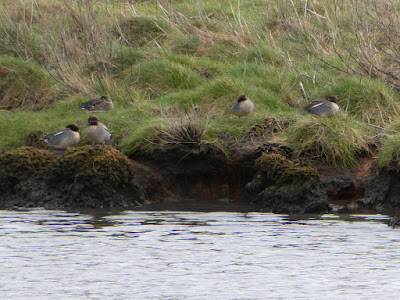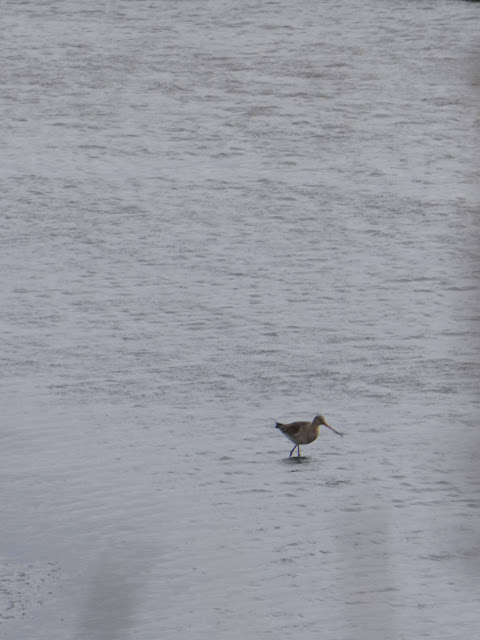A nice, short blog this one, covering a trip I had to Kinneil Kerse area with Fife Bird Club back in February.
Yes I know Kinneil Kerse is not in Fife, but the club are allowed stray across the border if they wish. In particular we were heading to the Kinneil Lagoon area, which lies on the shores of the River Forth between Bo'ness and Grangemouth. The Lagoon is fed by water from the River Forth during high tide using large underground pipes, which are designed so that all the water does not completely drain away during low tide. This means there is always an ideal combination of water and mud in the lagoon, an ideal sanctuary for wading birds and wildfowl.
You can park next to the Sewage Works (which brings back sensory memories of working for Scottish Water) and the view when you get out the car doesn't really paint an image of a nature reserve:
 |
| Grangemouth Petro-Chemical Industry |
 |
| Danger! Deep Lagoons |
We headed up on to the embankment that separates the lagoon from the River Forth and provides a viewpoint over the river at a point where the River Avon joins the Forth. It was an incoming tide and our first birds of note in this area was a small party of Scaup bobbing about just offshore:
 |
| Scaup near Kinneil Lagoons |
 |
| Two male and one female Scaup |
 |
| Bobbing Scaup |
This was the closest to the shore I had ever seen Scaup, they are normally too far away to get decent photos. Despite the strong wind that morning I even managed to get a reasonable video of them:
At a distance these sea ducks can easily be mistaken for Tufted Duck, but when they are as close as this you can make out that the males have a silver-grey back compared to the black back on Tufted Duck males; and the white on the faces of the females are much more obvious at close range (not present on female Tufted Ducks). They males also don't have 'tufts'.
After scanning the Firth for a while we decided to move along the embankment and head to the lagoon.
 |
| FBC members Scoping the Scaups |
 |
| Heading to Kinneil Lagoon |
The lagoon area is made up of a long channel running alongside the embankment with a large shallow lagoon at the far end. This lagoon is surrounded by steep sides and there are parcels of mudflats, reed beds and marshland within this enclosed area.
 |
| Kinneil Lagoon Area |
We spotted some Teal at the side of the channel and further inspection revealed a couple of Godwits (Bar-tailed I think, although I always have difficulty distinguishing between Bar-tailed and Black-tailed):
 |
| Teal on bank of channel |
 |
| Teal with Bar-tailed Godwit |
Here's a little video of the Teal and Godwit:
See if you can tell if they are Bar-tailed or Black-tailed.
On the other side of the channel was a bird you don't see very often, a long-legged Greenshank:
 |
| Greenshank in the channel |
 |
| Greenshank |
Apologies for quality of photo, it was quite far away and it was very windy. I am afraid the following video is not a lot better, but I'm sure that you can make out that it's a Greenshank:
We carried on along the embankment towards the lagoon, with the wind getting stronger by the minute. Just before we set up to scan the lagoon we passed some more Teal dabbling and preening in the channel:
 |
| Teal in the channel |
 |
| Teal Preening |
 |
| Teal Dabbling |
Here is a video illustrating how to dabble if you are a Teal:
We finally got to the point where the channel meets the lagoon and set up our scopes to see what was on the mudflats and the shallow lagoon waters. There were waders and wildfowl of all shapes and sizes including Redshank, Dunlin, Godwit, Curlew, Shellduck, Mallard and Lapwing (to name but a few).
After a short while scanning one of the FBC members spotted a Spotted Redshank and outlined its location to the rest of the group. It was at the end of a spit of land that juts out into the lagoon, it was quite far away and you needed a telescope to really distinguish it from other waders on the lagoon:
 |
| Spotted Redshank at Kinneil Lagoon |
 |
| Spotted Redshank |
It is quite a rare Winter visitor and this one had apparently been 'spotted' at Kinneil a few days back, but that was no guarantee that it would still be here. Just as some people were busy trying to get their bigger cameras out to take a decent photo of the bird it decided to fly off.
Luckily I caught this video just before it fled the scene:
We scanned the Lagoon area for another half hour or so, some Herons popped in, a couple of Roe Deer came down through the reedbed to the waterside and waders and ducks continued to flit between the Estuary and the Lagoon. It would have all been very peaceful and tranquil if hadn't been cold with a strong wind tugging at our zipped-up coats.
As per normal the birds all seemed to congregate at the far end of the lagoon, making it difficult to view them without a telescope and almost impossible to photograph them. Someone did notice that the Spotted Redshank had re-appeared on the mudflats on the far side of the Lagoon and that it had been joined by three Greenshanks. I did try to get some photographs of this little group of relatively rare birds, but they were not great:
 |
| Spotted Redshank and Three Greenshank (honest!) |
The video I took wasn't much better.......... well maybe just a little better:
After a little while we decided to call it a day and head back along the embankment.
On the way back we stopped to have another look at the Scaup, which had moved further down the river and had been joined by some other wildfowl, including some Goldeneye. Here is a slo-mo snapshot of the Goldeneye and Scaup, being upstaged by a Black-headed Gull.
When we got back to the cars we had a spot of lunch, some of the group were moving on to the Skinflats area but I decided to head home; hence why you have a short blog posting this time.
Hope you enjoyed it anyway
Take Care of yourselves
Cheers
TeddyEdward














































